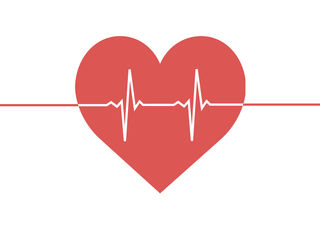Vagus Nerve
Can You Quantify Kids' Resilience?
Heart rate variability as a tool for measuring adaptability.
Posted March 30, 2018
Once upon a time I’d have thought that a heartbeat that remains steady and unvarying is a sign of strength. But to my surprise, cardiac consistency is the hobgoblin of weaker minds and bodies. “The stiffest tree is most easily cracked, while the bamboo or willow survives by bending with the wind,” the martial artist Bruce Lee said. So it is with the heart, which you want to bend to the ever-changing circumstances of the nervous system rather than pump on robotically, oblivious of the state of body and mind.
You want a heartbeat to be variable.
Heart rate variability (HRV) is a measure of irregularity in the intervals between beats. If you’re curious about how resilient you and your kid are, at least physiologically (which in the end can’t be separated from "cognitively"), you could do worse than to strap on a cheap, noninvasive heart monitor and download an app to measure your HRV. The subtle speed-up-slow-down between successive beats reveals more about resilience than does heart rate, which only counts the number of beats per minute. If the child has a heart rate of 120 beats per minutes she’s stressed or excited—that’s a no-brainer. With HRV, you also get a sense of how well she can respond to whatever’s going on and how well she’ll recover.
A high HRV measurement is generally a sign of resilience: the ability to adapt to and bounce back from stresses. In that context, it’s not much of a stretch to see how HRV is also linked with sociability, decision making, creativity, and problem solving.

The better the Buddha breath, the more Buddha-like the breather. We’re not all equals when it comes to deep abdominal exhales or any vagal-tone-boosting activity. A research group at the Max Planck Institute in Germany hypothesized that the people who do it easily and instinctively are friendlier and more generous than the norm. After all, virtuous traits require self-regulation, and anyone who automatically controls his or her breathing and heart rate variability under pressure has what it takes.
To test their idea, the researchers challenged a group of volunteers to a biofeedback task in which they had to reach a desired mind-body state to raise a ball on a screen. If a person exceeded an HRV threshold, the red spinning ball would rise. No one told the volunteers to use their Buddha breath, observation of the body, or any other technique to raise their HRV. Some did it naturally, as if they’d been controlling their hearts all their lives, and this group fascinated the researchers. Were these the people, they wondered, who’d put a coin in a beggar’s hat or stop the elevator door from closing to let in one more rider?
To find out, all the volunteers were given hypothetical scenarios in which they had money and could spend it, or not. Would they give it away charitably? Or would they maximize individual gain over group gain? How much did they favor an even distribution of wealth versus payouts only to people close to them? Were they purely generous, or did they only part with money when they expected something in return or when paying back those who helped them?
A pattern emerged, and with it a confirmation of the researchers’ hypothesis. The people who were good at raising their HRV on demand were indeed the same ones who gave away a fair amount of their money, and not merely out of social norms like reciprocity or punishment. Their generosity was motivated by altruism. You could say it came from the heart.
Other studies have found that you can predict compassion by looking at people’s heart rate variability. People who have an HRV upsurge when they see, for instance, suffering kittens or homeless people are more altruistic and willing to donate their money to a charity for the cause. People who maintain a higher-than-average HRV when hearing about sick children are more willing to share resources with them. In these cases, a high HRV is a sure sign of emotional responsiveness.
Think for a moment about why this might be. We know that high HRV is a triumph of the parasympathetic, the branch of the nervous system that increases a sense of calm. The vagus nerve is stimulated, which has the knock-on effect of a slower heart rate and respiration. This in turn redirects energy to other processes like social awareness and flexibility. (A faster heart rate, in contrast, activates the amygdala, which further primes the fear and anger response.) The vagus nerve also influences the release of oxytocin, the so-called calm-and-connect hormone.
Kids generally have much better vagal tone than adults, but there’s still a very wide spectrum.
Psychologists at the University of California, Davis wondered if preschoolers who have strong vagal tone would turn out to be more caring and empathetic years later than those with weaker tone. They launched a long-run experiment that began with a pool of three- and four-year-olds, each of whom was tested for vagal tone (using an HRV marker called respiratory sinus arrhythmia).
In the first stage of the experiment the kids witnessed an accident: an adult dropping everything in her arms as she fell and hurt herself. Which kids said, “Oh no!”? Which ones asked if she was OK? Which ones turned away, unmoved and expressionless, and went back to their toys? Behind-the-scenes experimenters rated each preschooler’s level of empathic concern. Can you guess which kids scored highest?
The children with strong vagal tone and high HRV, just as the researchers hypothesized. These kids noticed distress in others and empathized without being overwhelmed or threatened. They also perceived themselves as having more supportive friends. They had fewer adjustment problems, while those with poor vagal tone tended to be inhibited in new social situations and dislike novelty. Other studies show that the very act of giving and bonding strengthens vagal tone, which perpetuates a virtuous cycle.
What’s surprising to note is that the children in the study with the strongest empathic response had strong vagal tone, but not the strongest. There was a threshold over which kids with the highest HRV were less sympathetic than average. Why? At a certain point, people may be able to control their emotions so well that they’re capable of inhibiting feelings of personal distress or empathy for others.
Now, fast-forward five years, and the preschoolers in the UC Davis study are in third and fourth grades. The researchers could finally address their burning questions. Did the toddlers with the fairly strong vagal tone became more caring and sociable eight-year-olds compared to those with low vagal tone? Is heart rate variability in early childhood predictive of later behavior?
The answer is... yes. Generally speaking, the preschoolers with strong vagal tone were more likely to become grade-schoolers whose moms and teachers gave them high marks for comforting others in pain or volunteering to help. On the whole they were more sensitive to others in class and likelier compliment their peers than were kids with low vagal tone. They were likelier to stick up for a kid who was being bullied. Other studies show that children with strong vagal tone are less defensive when confronted by a frenemy or a dilemma or an intrusive albeit well-intended parent or, later, a romantic partner—all because their sympathetic fight-or-flight reflexes aren’t trigger-ready. They can control their own distress or anxiety more easily, which allows them to turn their attention outward.
On study found that people with high HRV even look more generous and approachable, as if you could pick them out in a crowd. (The vagus regulates muscles in the face and head, which is why you can tell from voice or expression if a person is stressed.) Or maybe they’ll pick you. An Australian study found that people with a high resting HRV are likelier to affiliate and favor others in a group more strongly than those with a low HRV even if that group is just a clutch of strangers who share a preference for the same art.
HRV is a sign of not just physiological adaptability but social adaptability.
Excerpted from Wits Guts Grit: All-Natural Biohacks for Raising Smart, Resilient Kids




